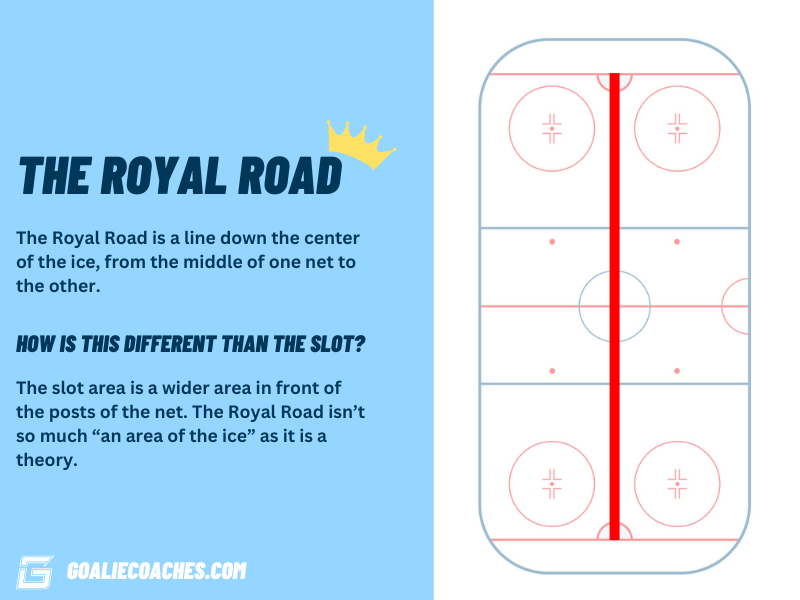The Royal Road is a line from the middle of one net on a hockey rink, to the middle of the other net. It was a term coined by former NHL goalie and professional Goalie Coach Steve Valiquette. Steve studied NHL goals scored during one season and found that 76% of goals were scored on “green shots”, or high percentage scoring opportunities. The other 24% were scored on red shots, with 8% of the goals that resulted from red shots being from rebounds of these initial shots.
Obviously, it is very difficult for goalies to make saves on plays where the puck is moving laterally, forcing the goalie to move laterally throughout their crease. One example I’ve used to make this easier to comprehend is the baseball scenario. If you were instructed to catch two baseballs, one of them while standing still and the other one while running, which do you think would be easier to catch?
If you answered “standing still”, you’d be correct. This is the principle concept in understanding why making saves on pucks that cross the Royal Road is more difficult than those that do not.
Want more advanced goaltending concepts? Explore the goalie training app we’ve built, designed to put a goalie coach in your pocket, no matter where in the world you may be.
Put a goalie coach in your pocket with the Goalie Coaches training app, built specifically for hockey goalies. The Goalie Coaches app has been used at every level of play, up to the NHL. Unlock hundreds of drills, game specific scenarios, and more inside the free app, today.
Is the Royal Road different than the slot area on a hockey rink?
Technically, the Royal Road is simply a line down the middle of the rink from the center of one net to the other. This is depicted in the photo below. The slot area is technically from the post of one net, to the post of the other, creating a wider zone that is right in front of the goalies net. Low slot shots are closer to the net and high slot shots are further away.

While calling this line the Royal Road may be more of a buzz word than anything, as the slot area somewhat defines this as well, it is one of the most critical things a goalie must defend during every game. If you want to become a better goalie, you must learn to give yourself maximum opportunity when pucks cross the Royal Road.
The video below shows the first segment on MSG where Valiquette spends 5 and a half minutes discussing the Royal Road and why it’s difficult for goalies to defend.
Why The Royal Road Is Critical for Goalies To Defend
As the game of hockey continues to get faster, goalies continue to adapt. Whether it’s different techniques like playing the RVH, faster lateral movement, or better puck tracking, goalies have evolved to defend against changing puck direction and high threat areas better than ever before.
Thus, opposing players are becoming well versed on what they need to do in order to improve their scoring chances. One of the most dangerous situations a goalie faces is when they do not have time to properly set and see the puck. The Royal Road concept includes two elements, green shots and red shots.
Green shots and red shots as it relates to the Royal Road
- Green shots: these are high percentage scoring opportunities where the goalie has less than 1/2 second to see the shot.
- Red shots: a red shot is a low percentage scoring opportunity where the goalie has more than 1/2 second to see the shot.
Think of the Royal Road as more of a theory rather than a zone on the ice. As goalies, the importance of the slot area is critical. This is because in the low slot, shots are happening right in front of the net, giving the goalie less time to react.
Pass shot scenarios present enough of a challenge as it is, but the difficulty only increases when pucks cross this imaginary line. This is due to two major factors that are critical to making saves. The first reason is the vision element. There is no thing more important in good goaltending than maintaining proper sight of the puck. The second is distance. As a rule, pucks that cross the center of the ice moving laterally force the goalie to cover a greater distance across the crease.
In the photo below, we’ve depicted two scenarios that both involve pass-shot situations. These are also referred to as “one timers”, if you’re completely new to the sport of hockey. In “Scenario A”, Player A passes to Player B for a shot on the same side of the Royal Road. In “Scenario B”, Player A passes to Player B for a shot on the opposite side of the Royal Road.
Which of these is more difficult to make a save against?
If you chose Scenario B, you’d be correct. Not only is this obviously more difficult to defend against, it’s statistically more difficult to defend against, as proven by Valiquette’s theory.

The reason saves are harder to make when pucks cross the Royal Road is due to two factors, both Vision and Distance.
On any shot on the same side of the playing surface, Scenario A in the image above, the goalie has a natural vision advantage as the majority of opposing threats will already be either in their field of vision or at the very least, their peripheral vision. When pucks cross the center of the ice, the Royal Road, this natural vision advantage is taken away.
The distance factor is simply that in order for the goalie to get a proper angle to the shot, as pucks cross a greater distance laterally the goalie must also cover a greater distance laterally. In Scenario A, the gap between the proper angle on Player A and Player B is very small. It’s a quick movement that can be done in a short amount of time. Obviously, Scenario B involves more lateral movement.
Not only does increased lateral movement reduce the amount of time a goalie has to get set for the next shot, it increases the opportunity for technical failure. This really doesn’t need to be that in depth, but one example of this is stick placement when moving laterally. The goalies stick is their best defense against shots in the “5 hole” area. Whenever goalies move laterally across the crease, they’re prone to moving the stick out of the 5 hole area, opening up a gap for pucks to sneak in. Quick pass shot scenarios take proper stick saves and for the most part, throw them out the window.








